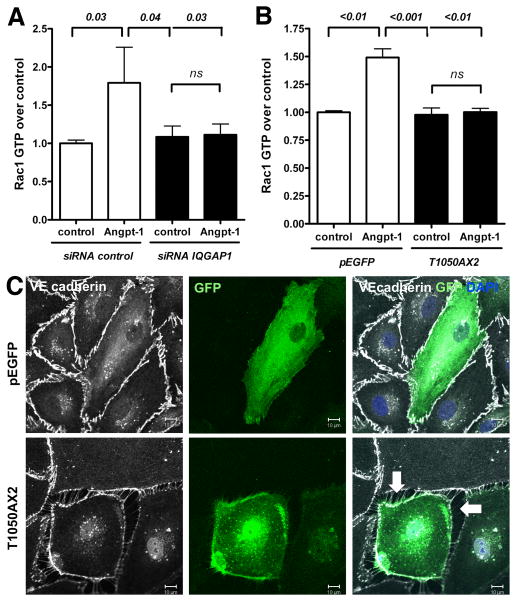Figure 5.
The IQ domain GTPase-activating protein 1 (IQGAP1)–Rac1 interaction is required for angiopoietin-1 (Angpt-1) to activate Rac1. A, Rac1 activation assay from confluent human microvascular endothelial cell (HMVEC) lysates transfected with control or IQGAP1 small interfering RNA (siRNA). Seventy-two hours after transfection, starved HMVECs were treated with Angpt-1 (300 ng/mL, 15 minutes) or vehicle. Only control-silenced cells were able to increase the amount of Rac1-GTP as a result of Angpt-1 treatment (n=6 per condition). B, Rac1 activation assay from confluent HMVEC lysates transfected with either a dominant negative IQGAP1-mutant disabled in Rac1 binding (T1050AX2) or with the corresponding backbone control vector (pEGFP). Seventy-two hours after transfection, starved HMVECs were treated with Angpt-1 (300 ng/mL, 15 minutes) or vehicle. ECs expressing T1050AX2 were not able to increase their endogenous Rac1-GTP abundance after Angpt-1 treatment (n=8 per condition). C, Immunocytochemistry for green fluorescent protein (GFP), VE-cadherin, and 4,6-diamidino-2-phenylindole (DAPI) 72 hours after transfection with either T1050AX2 IQGAP1-mutant or the corresponding backbone control vector (pEGFP). HMVECs expressing a high amount of T1050AX2 IQGAP1 (as indicated by extensive GFP signal) lost contact with adjacent ECs and formed paracellular gaps similar to those seen before in IQGAP1-silenced cells (representative of 3 experiments, scale bar=10 μm).

